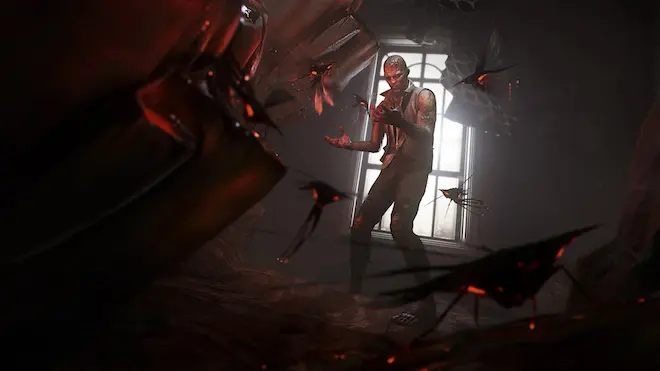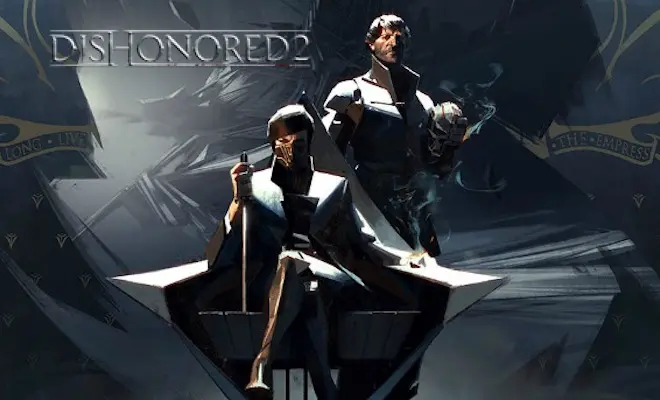In 2012, I named Dishonored as my Game of the Year. The combination of the stellar art direction, deep, well-planned mythology, amazing play control, and the freedom of choice in every mission really spoke to me, and took me on a lengthy adventure that was equal parts memorable and emotional. When I finished the first Dishonored game, I immediately restarted it and played it again, making different choices, trying for the second, different ending. To put it bluntly, I played the hell out of that game. Now, Dishonored 2 looks to not only continue to story of Corvo Attano and his daughter, Emily Kaldwin, now Empress Emily Kaldwin, but by adding the choice of which character to play as, each with a paragon path to explore, Arkane Studios has doubled down on 2012’s game of the year, and delivered a very strong contender for 2016’s best game.
Dishonored 2 picks up 15 years after the events in the first game. Emily has quietly sat on the throne in Dunwall, and Corvo, her birth father, has served as her royal protector, training her in the art of stealth, and being a sounding board for affairs of state. On the anniversary of Lady Jessamine’s death, Dunwall throws a celebration, and when Luca Abele, the Duke or Serkonos shows up to pay his respects, he brings with him a retinue of clockwork soldiers, robotic creations that are as deadly as the they are imposing. The duke introduces his guest, Delilah Copperspoon, who Abele declares is the rightful heir to the throne, as Delilah is Jessamine’s long lost sister. The duke’s Clockwork soldiers quickly kill any resistance, and Delilah, a witch with dark powers like Corvo and Emily, subdues one, leaving the other to fight to restore oder in Dunwall.
I chose to play as Emily first, and her story sees her escaping the palace and seeking aid from Megan Foster, an ally of her father’s. Megan and Emily work in the shadows to take out the conspirators that took her throne, and to learn the dark secrets of the Kaldwin family, secrets that may or may not prove that Delilah is the rightful heir.
As in the first game, Dishonored 2 has a Metroid-like progression, as Emily grows stronger and learns new powers as the story progresses. A visit from the Outsider gives her a choice to play the game with dark powers, or to forgo that and use only weapons. These Outsider interludes throughout the game help tell the darker side of the story, and much like Corvo’s journey, Emily can go full on chaos mode in her quest for revenge. And truth be told, that’s the way I played it. My Emily was a demon, who killed those her usurped her power without remorse.
Each of the game’s main assassinations (on the conspirators who helped overthrow Emily) gives the player the option to kill (high chaos) or ruin (low chaos), and while it is very easy to just sneak up and kill someone from the shadows, the true joy of a job well done is in the unique way Arkane Studios gives players to do some creative ruining. In one mission, I opted to go the low chaos route and ruin the cocky genius who created the Clockwork soldiers. I knocked him out, strapped him into a electro-shock therapy chair, and them proceeded to fry his brain into paste. He still lives, but he subsists on soup and calls everyone mommy. Sadistic and satisfying.
Emily also has different skills than her father, so playing as the young empress gave me a different perspective in many ways. Collecting runes, bone charms, and blueprints for weapon upgrades turned my Emily into a machine of destruction, and gave me reason to search every square inch of every level. Once again, Arkane has completely outdone themselves with the level designs here. The art direction is one of the best in gaming — all gaming — and it works so incredibly well here in this world that they’ve created. This is a universe that is powered by whale oil, and the amalgam of past and future, with a splash of steampunk makes for the perfect playground to conduct my dark business.
Dishonored 2 also puts much emphasis on not only the choices of how the character is played, but how to play the game. Essentially, the player is tasked with a mission, like “assassinate Duke Abele” and then Arkane thrusts you into a level with many doors, windows, paths, and so many other ways of ingress and egress. Figuring out the puzzle of how to get in unseen, or as loud as you want (again, choice!) is part of what makes this game and series so special. I can play the game multiple times and never do the same things twice.
One level midway through the game allows for selective time travel using a cursed device that the player acquires. I cannot stress enough how cool of a feature this was, as I “bamf’d” back and forth between past and present to kill my enemies. Using a “window” on the device to see into the other time period, I could position myself behind enemies in the past by standing in that spot in the present, and then warp to deliver a killing strike, and then warp back before anyone knew what had happened. I had the most fun in this level, and it is one that will stay with me for a long time to come.
And as the chaos level rises and falls, the world changes. Streets become infested with blood flies (replacing the rat plague from the first game), and even conversations and demeanors change. Emily starts out hopeful that she can peacefully regain her throne, but near the end of my violent campaign to exact revenge, her lines spoke more of wanting to rip off the heads of her enemies and then defecate down their necks. My choices seemed to not only affect my ending, but the world as I played it.
The music and sound effects in Dishonored 2 are once again stellar. A good soundtrack can serves as the glue that holds a game together, and composer Daniel Licht nailed it here. The voice acting, which includes the likes of Vincent D’Onofrio as Duke Abele, and Rosario Dawson as Megan Foster, and Robin Lord Taylor (Gotham’s Penguin) as The Outsider, really helps to bring some star power to the affair.
The Dishonored games have both really spoken to me as a gamer. The freedom of choice is a big part of that, and in Dishonored 2, the added choice of which protagonist to play means that there is an incredible amount of replayability here. The 30-plus hour campaign is not only doubled for completionists, it is quadrupled, making Dishonored 2 one epic time suck of a game. The amazing level design, cool dark powers, and interesting characters, both good and bad, just works to set this game apart from any of its peers in 2016. Bethesda and Arkane Studios have a new franchise here, one that I would love to revisit every few years, as after two games, they’ve proven that 2012’s game of the year was no fluke, and that the story of Dishonored is worthy of additional chapters for years to come.
Dishonored 2 is available now for Playstation 4, Xbox One, and PC. This review is based off the Playstation 4 version, purchased at retail.









